Thermal Performance in Convection Flow of Nanofluids Using a Deep Convolutional Neural Network
Abstract
:1. Introduction
2. Methods
2.1. Preparation of Dataset
2.1.1. Mathematical Framework
- Governing Equations
- 2.
- Constitutive Equations
- 3.
- The expanded form of the governing equations
2.1.2. Physical Model and Numerical Simulation
2.2. Establishment of the Nanofluid Field Predictor
2.2.1. Architecture Design of the Nanofluid Field Predictor
2.2.2. Model Training and Evaluation Method
3. Results and Discussions
3.1. Temperature Prediction Results of the Geometry Adaptive Predictor
3.2. Nusselt Number Prediction of the Geometry Adaptive Predictor
3.3. Influence of Data Size
4. Conclusions
- For the case of single inner cylinder, the predictor can adapt both the inner cylinder size and the placement, where the accuracy of the temperature field is higher than 99.9% and the coefficient of determination of the Nusselt number prediction reaches 0.9987.
- For the case of the double-inner-cylinder annulus, which has a more complex geometry, the temperature prediction accuracy and the values of the Nusselt number prediction are not far from the results of the single-inner-cylinder case, 99.8% and 0.9901, respectively, with the inner ring placement adaptive ability.
- In addition, the proposed predictor takes much less time in both the nanofluid field prediction and the input data pretreatment. In particular, the prediction time is four orders faster.
Author Contributions
Funding
Conflicts of Interest
References
- Guo, Z.X.; Cheng, L.X.; Cao, H.X.; Zhang, H.; Huang, X.; Min, J. Heat Transfer Enhancement—A Brief Reviw of Literature in 2020 and Prospects. Heat Transf. Res. 2020, 52, 65–92. [Google Scholar] [CrossRef]
- Choi, S.U.S.; Eastman, J. Enhancing Thermal Conductivity of Fluids with Nanoparticles; United States. Department of Energy: Washington, DC, USA; The Office of Scientific and Technical Information, U.S. Department of Energy: Oak Ridge, TN, USA, 1995; Volume 66. [Google Scholar]
- Wang, X.Q.; Mujumdar, A.S. Heat Transfer Characteristics of Nanofluids: A Review. Int. J. Therm. Sci. 2007, 46, 1–19. [Google Scholar] [CrossRef]
- Pordanjani, A.H.; Aghakhani, S.; Afrand, M.; Sharifpur, M.; Meyer, J.P.; Xu, H.J.; Ali, H.M.; Karimi, N.; Cheraghian, G. Nanofluids: Physical Phenomena, Applications in Thermal Systems and the Environment Effects—A Critical Review. J. Clean. Prod. 2021, 320, 128573. [Google Scholar] [CrossRef]
- Abu-Nada, E.; Masoud, Z.; Hijazi, A. Natural Convection Heat Transfer Enhancement in Horizontal Concentric Annuli Using Nanofluids. Int. Commun. Heat Mass Transf. 2008, 35, 657–665. [Google Scholar] [CrossRef]
- Wang, W.; Liu, G.; Li, B.W.; Rao, Z.H.; Wang, H.; Liao, S.M. Momentum and Heat Transfer Characteristics of Three-Dimensional CuO/Water Nanofluid Flow in a Horizontal Annulus: Influences of Nanoparticle Volume Fraction and Its Mean Diameter. J. Therm. Anal. Calorim. 2022, 147, 1757–1772. [Google Scholar] [CrossRef]
- Sankar, M.; Reddy, N.K.; Do, Y. Conjugate Buoyant Convective Transport of Nanofluids in an Enclosed Annular Geometry. Sci. Rep. 2021, 11, 17122. [Google Scholar] [CrossRef]
- Berrahil, F.; Filali, A.; Abid, C.; Benissaad, S.; Bessaih, R.; Matar, O. Numerical Investigation on Natural Convection of Al2O3/Water Nanofluid with Variable Properties in an Annular Enclosure under Magnetic Field. Int. Commun. Heat Mass Transf. 2021, 126, 105408. [Google Scholar] [CrossRef]
- Cao, Y.; Ayed, H.; Togun, H.; Shawabkeh, A.; Dahari, M.; Wae-hayee, M.; Mouldi, A.; Marzouki, R. Heating a Cold Semi-Annulus Wall by MHD Natural Convetion with Nanofluid. Case Stud. Therm. Eng. 2021, 28, 101569. [Google Scholar] [CrossRef]
- Rozati, S.A.; Montazerifar, F.; Ali Akbari, O.; Hoseinzadeh, S.; Nikkhah, V.; Marzban, A.; Abdolvand, H.; Goodarzi, M. Natural Convection Heat Transfer of Water/Ag Nanofluid inside an Elliptical Enclosure with Different Attack Angles. Math. Methods Appl. Sci. 2020, 1–18. [Google Scholar] [CrossRef]
- Arefmanesh, A.; Amini, M.; Mahmoodi, M.; Najafi, M. Buoyancy-Driven Heat Transfer Analysis in Two-Square Duct Annuli Filled with a Nanofluid. Eur. J. Mech. B Fluids 2012, 33, 95–104. [Google Scholar] [CrossRef]
- Xu, X.; Sun, G.; Yu, Z.; Hu, Y.; Fan, L.; Cen, K. Numerical Investigation of Laminar Natural Convective Heat Transfer from a Horizontal Triangular Cylinder to Its Concentric Cylindrical Enclosure. Int. J. Heat Mass Transf. 2009, 52, 3176–3186. [Google Scholar] [CrossRef]
- Yu, Z.T.; Xu, X.; Hu, Y.C.; Fan, L.W.; Cen, K.F. A Numerical Investigation of Transient Natural Convection Heat Transfer of Aqueous Nanofluids in a Horizontal Concentric Annulus. Int. J. Heat Mass Transf. 2012, 55, 1141–1148. [Google Scholar] [CrossRef]
- Mehrizi, A.A.; Farhadi, M.; Shayamehr, S. Natural Convection Flow of Cu-Water Nanofluid in Horizontal Cylindrical Annuli with Inner Triangular Cylinder Using Lattice Boltzmann Method. Int. Commun. Heat Mass Transf. 2013, 44, 147–156. [Google Scholar] [CrossRef]
- Saeedan, M.; Solaimany Nazar, A.R.; Abbasi, Y.; Karimi, R. CFD Investigation and Neutral Network Modeling of Heat Transfer and Pressure Drop of Nanofluids in Double Pipe Helically Baffled Heat Exchanger with a 3-D Fined Tube. Appl. Therm. Eng. 2016, 100, 721–729. [Google Scholar] [CrossRef]
- Maddah, H.; Ghasemi, N.; Keyvani, B.; Cheraghali, R. Experimental and Numerical Study of Nanofluid in Heat Exchanger Fitted by Modified Twisted Tape: Exergy Analysis and ANN Prediction Model. Heat Mass Transf. Stoffuebertragung 2017, 53, 1413–1423. [Google Scholar] [CrossRef]
- Ashouri, M.; Hashemi, A. A Transfer Learning Metamodel Using Artificial Neural Networks for Natural Convection Flows in Enclosures. Case Stud. Therm. Eng. 2022, 36, 102179. [Google Scholar] [CrossRef]
- Liu, T.; Li, Y.; Jing, Q.; Xie, Y.; Zhang, D. Supervised Learning Method for the Physical Field Reconstruction in a Nanofluid Heat Transfer Problem. Int. J. Heat Mass Transf. 2021, 165, 120684. [Google Scholar] [CrossRef]
- Liu, T.; Li, Y.; Xie, Y.; Zhang, D. Deep Learning for Nanofluid Field Reconstruction in Experimental Analysis. IEEE Access 2020, 8, 64692–64706. [Google Scholar] [CrossRef]
- Li, Y.; Liu, Z.; Wang, Y.; Liu, T.; Xie, Y. Real-Time Physical Field Reconstruction for Nanofluids Convection Using Deep Learning with Auxiliary Tasks. Numer. Heat Transf. Part A Appl. 2022, 1–24. [Google Scholar] [CrossRef]
- Li, Y.; Liu, T.; Xie, Y. Thermal Fluid Fields Reconstruction for Nanofluids Convection Based on Physics-Informed Deep Learning. Sci. Rep. 2022, 12, 12567. [Google Scholar] [CrossRef]
- Peng, J.-Z.; Liu, X.; Aubry, N.; Chen, Z.; Wu, W.-T.T.; Xia, Z.-D.D.; Aubry, N.; Chen, Z.; Wu, W.-T.T.; Xia, Z.-D.D.; et al. Data-Driven Modeling of Geometry-Adaptive Steady Heat Conduction Based on Convolutional Neural Networks. Case Stud. Therm. Eng. 2021, 28, 101651. [Google Scholar] [CrossRef]
- Peng, J.-Z.; Liu, X.; Xia, Z.-D.; Aubry, N.; Chen, Z.; Wu, W.-T. Data-Driven Modeling of Geometry-Adaptive Steady Heat Convection Based on Convolutional Neural Networks. Fluids 2021, 6, 436. [Google Scholar] [CrossRef]
- Peng, J.-Z.; Aubry, N.; Zhu, S.; Chen, Z.; Wu, W.-T. Geometry and Boundary Condition Adaptive Data-Driven Model of Fluid Flow Based on Deep Convolutional Neural Networks. Phys. Fluids 2021, 33, 123602. [Google Scholar] [CrossRef]
- Peng, J.-Z.; Chen, S.; Aubry, N.; Chen, Z.; Wu, W.T. Unsteady reduced-order model of flow over cylinders based on convolutional and deconvolutional neural network structure. Phys. Fluids 2020, 32, 123609. [Google Scholar] [CrossRef]
- Bhatnagar, S.; Afshar, Y.; Pan, S.; Duraisamy, K.; Kaushik, S. Prediction of Aerodynamic Flow Fields Using Convolutional Neural Networks. Comput. Mech. 2019, 64, 525–545. [Google Scholar] [CrossRef] [Green Version]
- Slattery, J.C. Advanced Transport Phenomena; Cambridge University Press: Cambridge, UK, 1999; ISBN 1316583902. [Google Scholar]
- Liu, I.-S. Continuum Mechanics; Springer Science & Business Media: Berlin, Germany, 2002. [Google Scholar]
- Miao, L.; Massoudi, M. Effects of Shear Dependent Viscosity and Variable Thermal Conductivity on the Flow and Heat Transfer in a Slurry. Energies 2015, 8, 11546–11574. [Google Scholar] [CrossRef] [Green Version]
- Yang, H.J.; Aubry, N.; Massoudi, M. Heat Transfer in Granular Materials: Effects of Nonlinear Heat Conduction and Viscous Dissipation. Math. Methods Appl. Sci. 2013, 36, 1947–1964. [Google Scholar] [CrossRef]
- Yang, H.; Massoudi, M. Conduction and Convection Heat Transfer in a Dense Granular Suspension. Appl. Math. Comput. 2018, 332, 351–362. [Google Scholar] [CrossRef]
- Massoudi, M. On the Heat Flux Vector for Flowing Granular Materials—Part I: Effective Thermal Conductivity and Background. Math. Methods Appl. Sci. 2006, 29, 1585–1598. [Google Scholar] [CrossRef]
- Massoudi, M. On the Heat Flux Vector for Flowing Granular Materials—Part II: Derivation and Special Cases. Math. Methods Appl. Sci. 2006, 29, 1599–1613. [Google Scholar] [CrossRef]
- Massoudi, M.; Kirwan, A.D. On Thermomechanics of a Nonlinear Heat Conducting Suspension. Fluids 2016, 1, 19. [Google Scholar] [CrossRef]
- Massoudi, M.; Christie, I. Natural Convection Flow of a Non-Newtonian Fluid between Two Concentric Vertical Cylinders. Acta Mech. 1990, 82, 11–19. [Google Scholar] [CrossRef]
- Rajagopal, K.R.; Ruzicka, M.; Srinivasa, A.R. On the Oberbeck-Boussinesq Approximation. Math. Model. Methods Appl. Sci. 1996, 6, 1157–1167. [Google Scholar] [CrossRef]
- Massoudi, M.; Vaidya, A.; Wulandana, R. Natural Convection Flow of a Generalized Second Grade Fluid between Two Vertical Walls. Nonlinear Anal. World Appl. 2008, 9, 80–93. [Google Scholar] [CrossRef]
- Rajagopal, K.R.; Saccomandi, G.; Vergori, L. On the Oberbeck-Boussinesq Approximation for Fluids with Pressure Dependent Viscosities. Nonlinear Anal. World Appl. 2009, 10, 1139–1150. [Google Scholar] [CrossRef]
- Tao, C.; Wu, W.T.; Massoudi, M. Natural Convection in a Non-Newtonian Fluid: Effects of Particle Concentration. Fluids 2019, 4, 192. [Google Scholar] [CrossRef] [Green Version]
- Sun, X.H.; Massoudi, M.; Aubry, N.; Chen, Z.H.; Wu, W.T. Natural Convection and Anisotropic Heat Transfer in a Ferro-Nanofluid under Magnetic Field. Int. J. Heat Mass Transf. 2019, 133, 581–595. [Google Scholar] [CrossRef]
- Phuoc, T.X.; Massoudi, M. Experimental Observations of the Effects of Shear Rates and Particle Concentration on the Viscosity of Fe2O3-Deionized Water Nanofluids. Int. J. Therm. Sci. 2009, 48, 1294–1301. [Google Scholar] [CrossRef]
- Phuoc, T.X.; Massoudi, M.; Chen, R.H. Viscosity and Thermal Conductivity of Nanofluids Containing Multi-Walled Carbon Nanotubes Stabilized by Chitosan. Int. J. Therm. Sci. 2011, 50, 12–18. [Google Scholar] [CrossRef]
- Massoudi, M.; Phuoc, T.X. Remarks on Constitutive Modeling of Nanofluids. Adv. Mech. Eng. 2012, 6, 927580. [Google Scholar] [CrossRef]
- Benkhedda, M.; Bensouici, F.; Boufendi, T. Parametric Study of Nanoparticles Effects on Convective Heat Transfer of Nanofluids in a Heated Horizontal Annulus Parametric Study of Nanoparticles Effects on Convective Heat Transfer of Nanofluids in a Heated Horizontal Annulus. J. Nano Res. 2021, 70, 81–100. [Google Scholar] [CrossRef]
- Ebrahimi-Moghadam, A.; Mohseni-Gharyehsafa, B.; Farzaneh-Gord, M. Using Artificial Neural Network and Quadratic Algorithm for Minimizing Entropy Generation of Al2O3-EG/W Nanofluid Flow inside Parabolic Trough Solar Collector. Renew. Energy 2018, 129, 473–485. [Google Scholar] [CrossRef]
- Prusa, V.; Rajagopal, K.R. On models for viscoelastic materials that are mechanically incompressible and thermally compressible or expansible and their oberbeck-boussinesq type approximations. Math. Model. Methods Appl. Sci. 2013, 23, 1761–1794. [Google Scholar] [CrossRef]
- Theodoridis, S. Chapter 18—Neural Networks and Deep Learning. In Machine Learning, 2nd ed.; Academic Press: Washington, DC, USA, 2020; pp. 901–1038. ISBN 978-0-12-818803-3. [Google Scholar] [CrossRef]
- Clevert, D.A.; Unterthiner, T.; Hochreiter, S. Fast and Accurate Deep Network Learning by Exponential Linear Units (ELUs). In Proceedings of the 4th International Conference Learning Representations ICLR 2016—Conference Track Proceedings, San Juan, Puerto Rico, 2–4 May 2016; pp. 1–14. [Google Scholar]
- Witten, I.H.; Frank, E.; Hall, M.A. Chapter 5—Credibility: Evaluating What’s Been Learned. In The Morgan Kaufmann Series in Data Management Systems, 3rd ed.; Witten, I.H., Frank, E., Eds.; Morgan Kaufmann: Boston, MA, USA, 2011; pp. 147–187. ISBN 978-0-12-374856-0. [Google Scholar]
- Kingma, D.P.; Ba, J.; Lei Ba, J. ADAM: A Method for Stochastic Optimization. In Proceedings of the 3rd International Conference for Learning Representations, San Diego, CA, USA, 7–9 May 2015; pp. 1–15. [Google Scholar]
- Liu, Y.; Zhang, Z.; Liu, X.; Wang, L.; Xia, X. Ore Image Classification Based on Small Deep Learning Model: Evaluation and Optimization of Model Depth, Model Structure and Data Size. Miner. Eng. 2021, 172, 107020. [Google Scholar] [CrossRef]
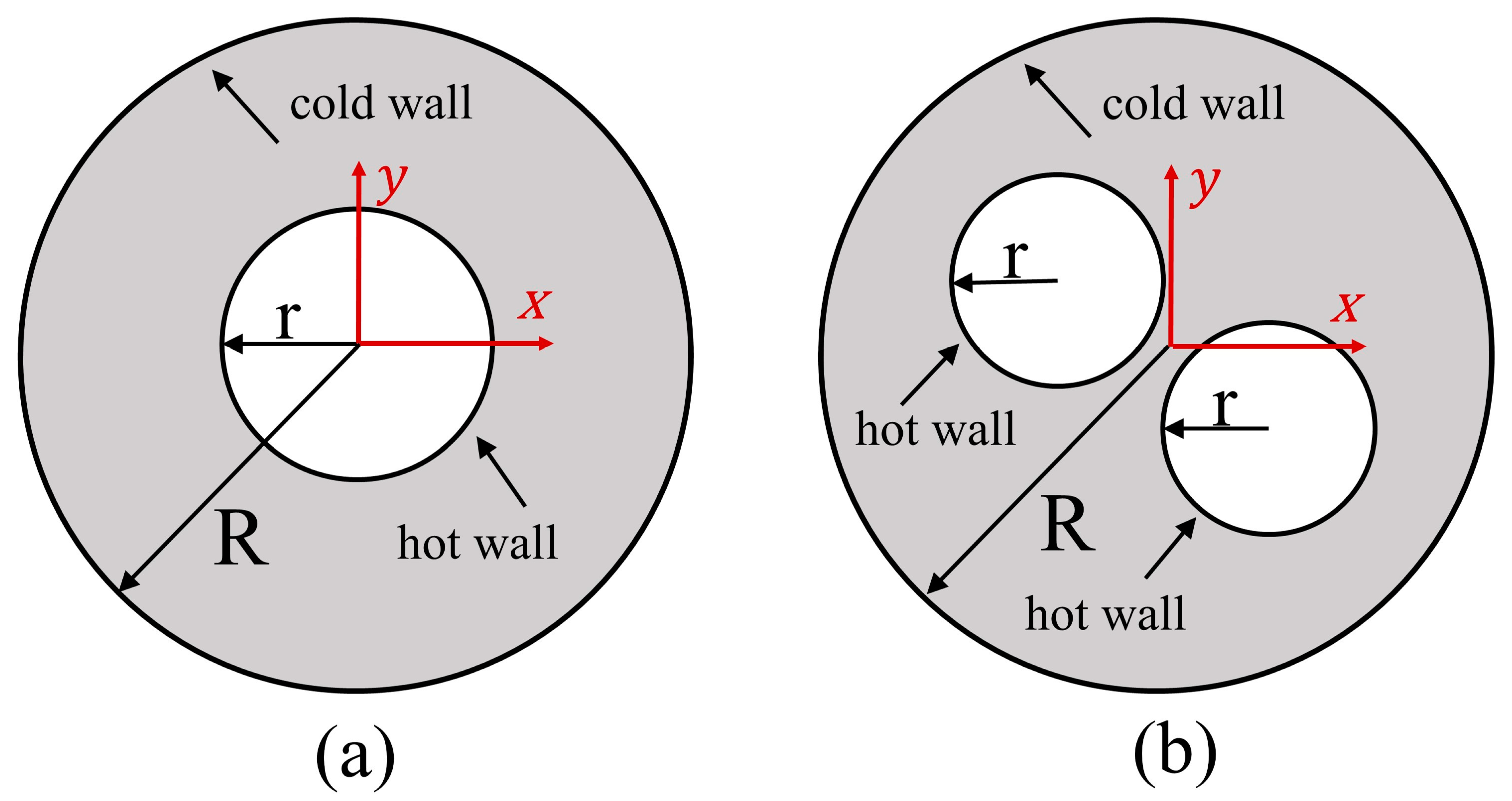
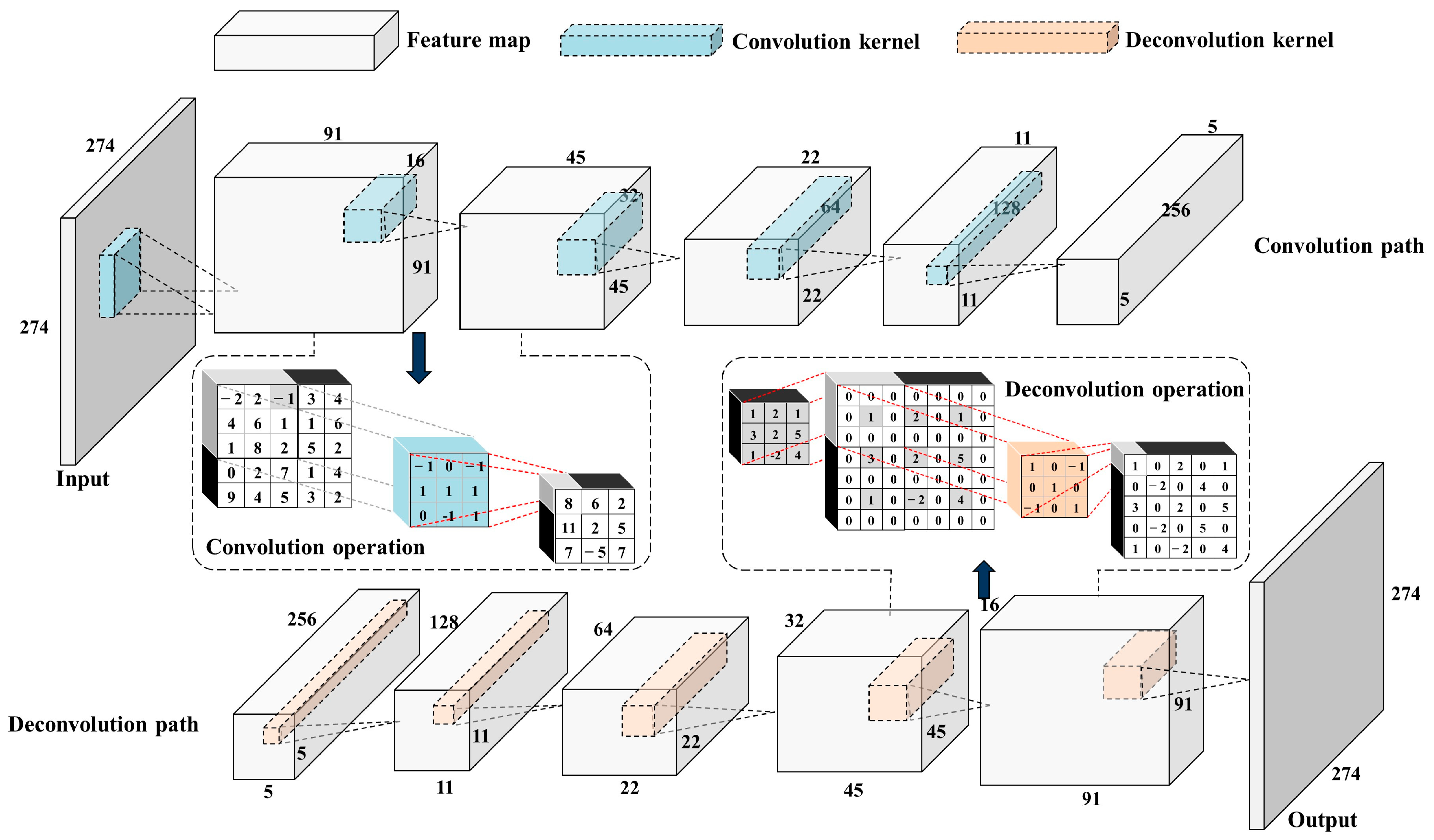
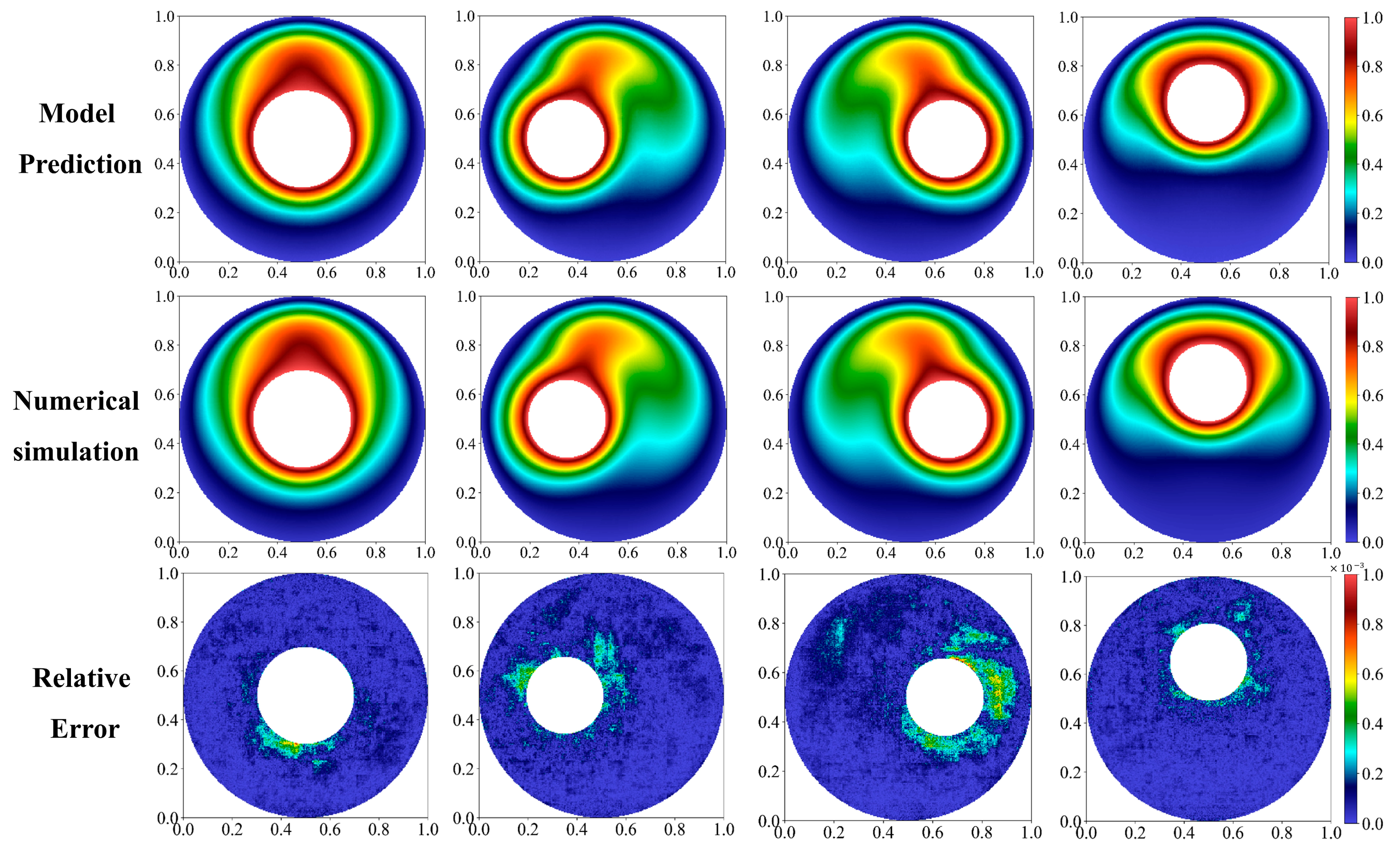
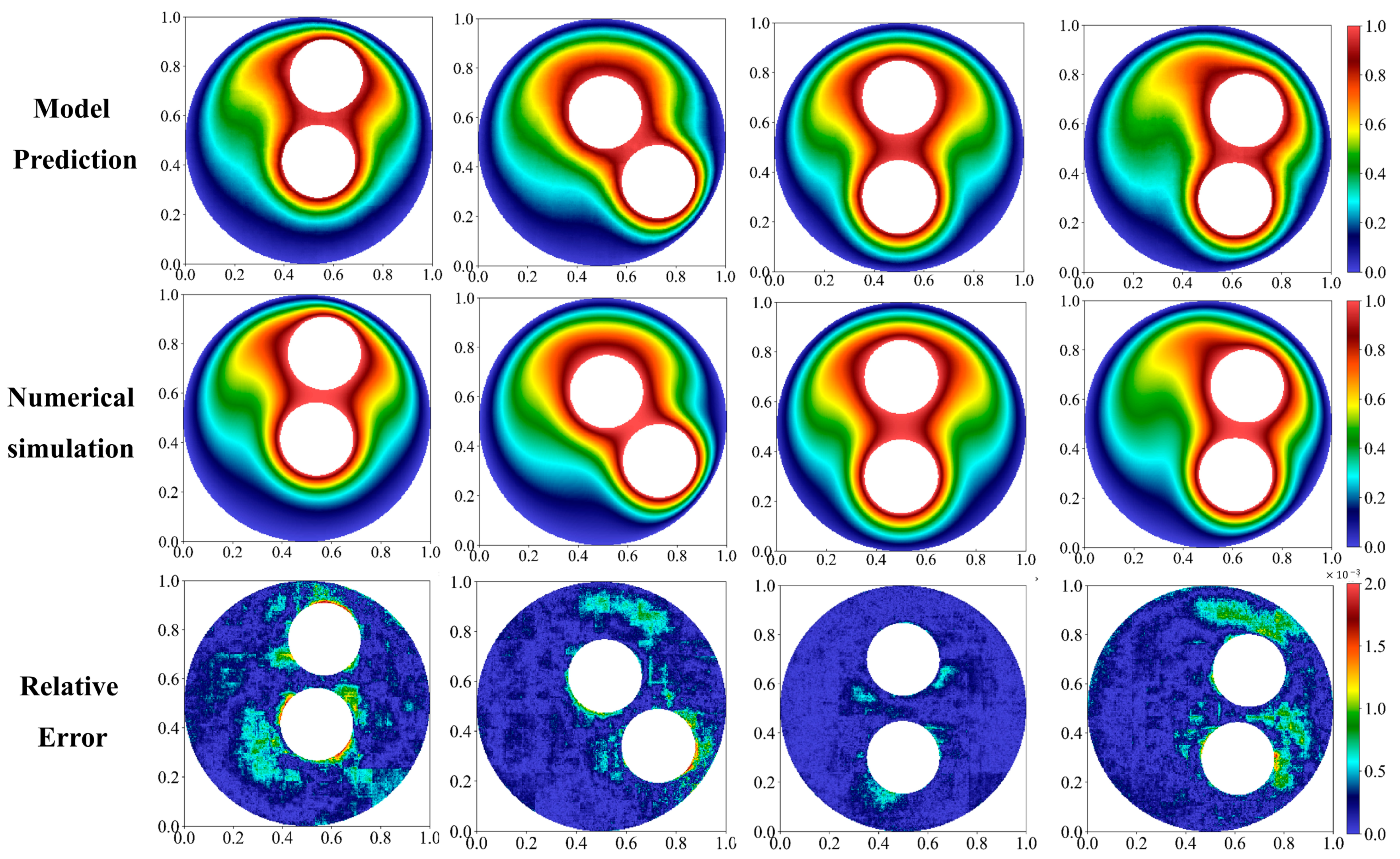
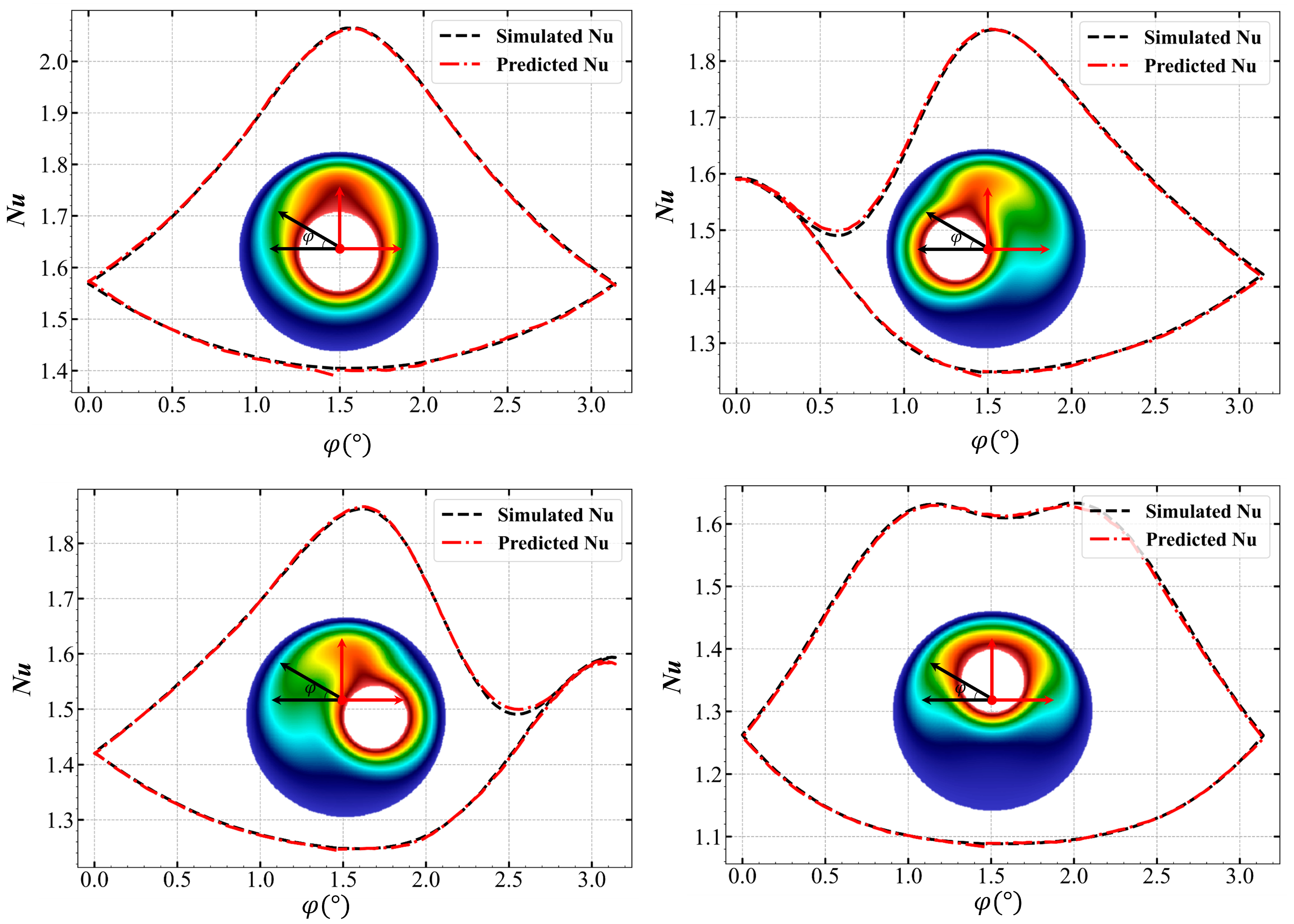

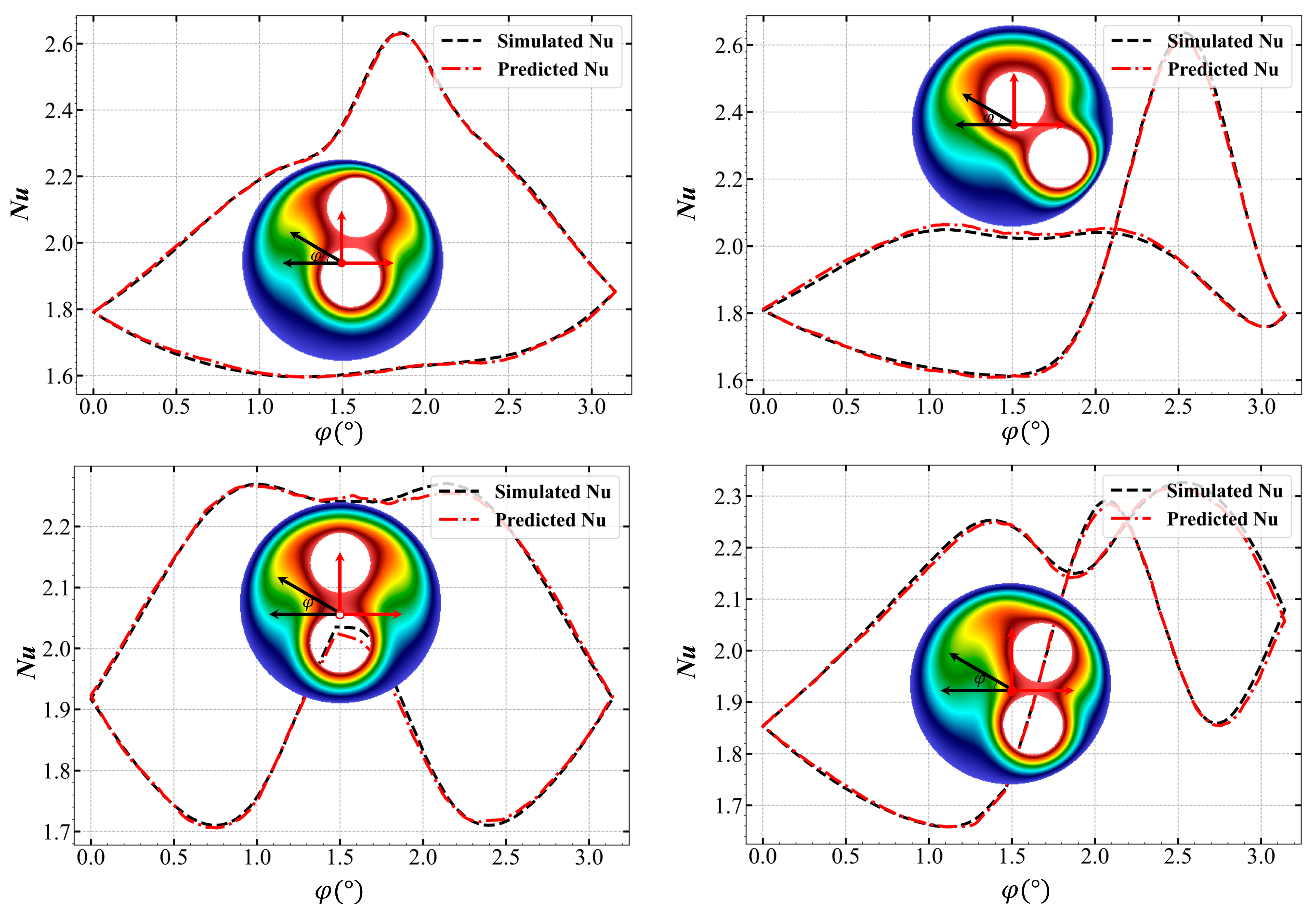


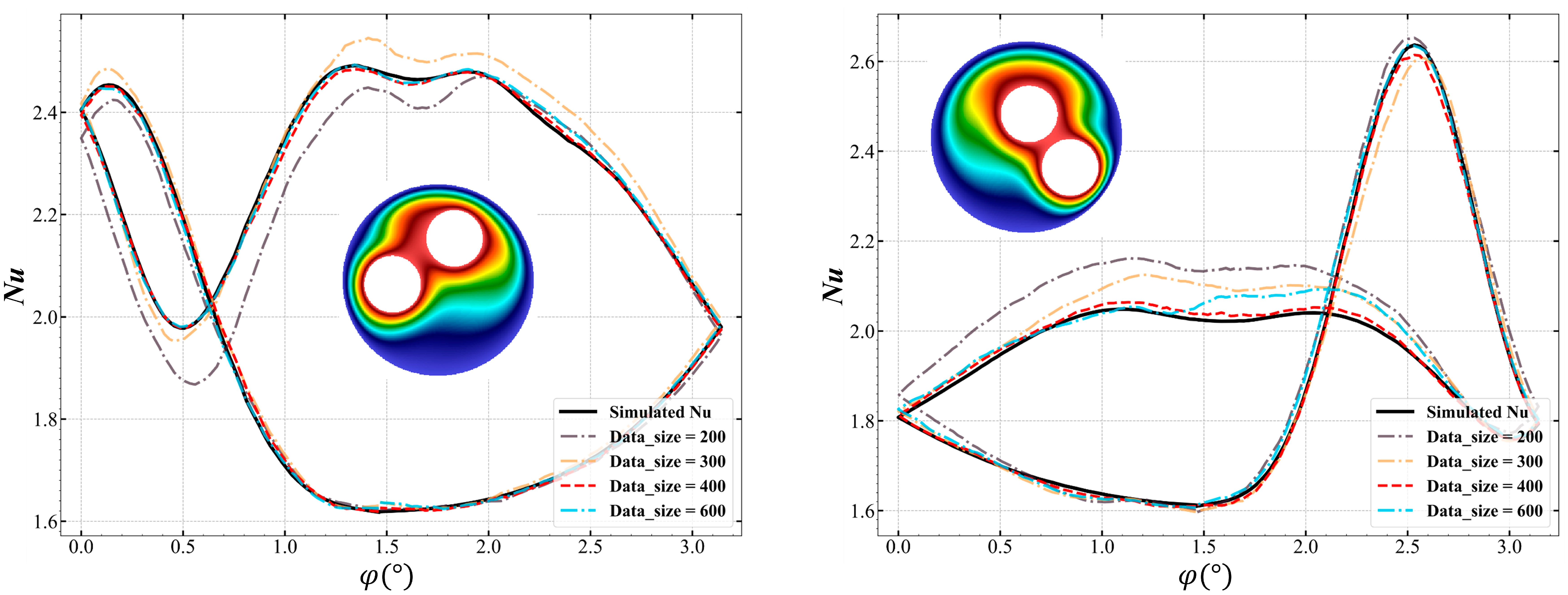
| (m2/s) | (kg/m3) | (1/K) | (m2/s) |
|---|---|---|---|
| 1209 |
| Time Cost | Pretreatment | ||
|---|---|---|---|
| Network predictor | Temperature | 0.0382 s | 0.032 s (NWSDF) |
| Nu number | 0.0388 s | ||
| Numerical solver | data | 430 s | 3.09 s (mesh) |
Publisher’s Note: MDPI stays neutral with regard to jurisdictional claims in published maps and institutional affiliations. |
© 2022 by the authors. Licensee MDPI, Basel, Switzerland. This article is an open access article distributed under the terms and conditions of the Creative Commons Attribution (CC BY) license (https://creativecommons.org/licenses/by/4.0/).
Share and Cite
Hua, Y.; Peng, J.-Z.; Zhou, Z.-F.; Wu, W.-T.; He, Y.; Massoudi, M. Thermal Performance in Convection Flow of Nanofluids Using a Deep Convolutional Neural Network. Energies 2022, 15, 8195. https://doi.org/10.3390/en15218195
Hua Y, Peng J-Z, Zhou Z-F, Wu W-T, He Y, Massoudi M. Thermal Performance in Convection Flow of Nanofluids Using a Deep Convolutional Neural Network. Energies. 2022; 15(21):8195. https://doi.org/10.3390/en15218195
Chicago/Turabian StyleHua, Yue, Jiang-Zhou Peng, Zhi-Fu Zhou, Wei-Tao Wu, Yong He, and Mehrdad Massoudi. 2022. "Thermal Performance in Convection Flow of Nanofluids Using a Deep Convolutional Neural Network" Energies 15, no. 21: 8195. https://doi.org/10.3390/en15218195
APA StyleHua, Y., Peng, J.-Z., Zhou, Z.-F., Wu, W.-T., He, Y., & Massoudi, M. (2022). Thermal Performance in Convection Flow of Nanofluids Using a Deep Convolutional Neural Network. Energies, 15(21), 8195. https://doi.org/10.3390/en15218195







